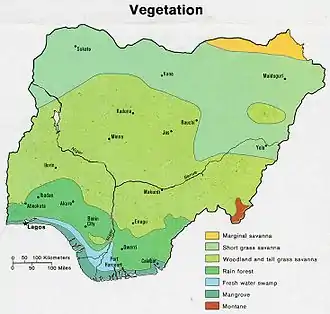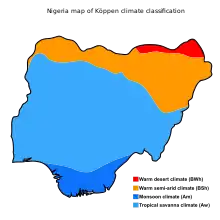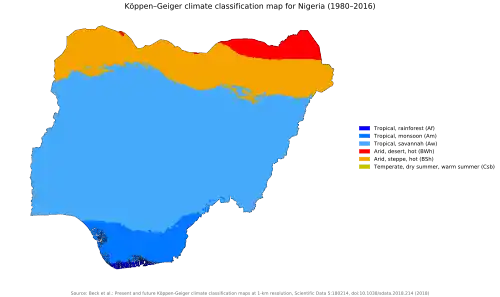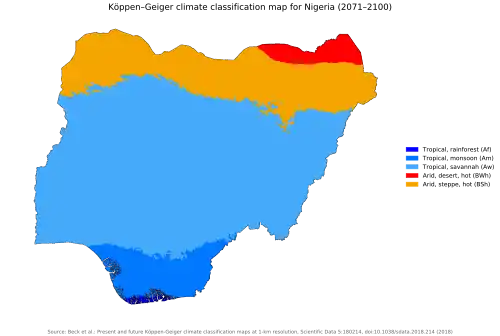Climate change in Nigeria
Climate change in Nigeria is evident from temperature increase, rainfall variability (increasing rainfall in coastal areas and decline in rainfall in the continental areas), drought, desertification, rising sea levels, erosions, floods, thunderstorms, lightings, bush fires, landslides, land degradation, and loss of biodiversity.[1] All of these will continue to negatively affect human life and the ecosystems in Nigeria.[2] Although depending on location, regions experience climate change with significant higher temperatures during the dry seasons while rainfalls during rainy seasons help keep the temperature at milder levels.
The associated challenges of climate change are not the same across the country because of the two precipitation regimes: high precipitation in parts of the Southeast and Southwest and low precipitation in the North. These regimes can result into aridity, desertification and drought in the north; and erosion and flooding in the South.[3][4]


Background
Nigeria has a tropical climate with 2 seasons (wet and dry).
Inland areas especially those in the northeast, experience the greatest fluctuations in temperatures as before the onset of rains, temperatures sometimes rise as high as 44 °C and drops to 6 °C between December to February. In Maiduguri, the maximum temperature may rise to 38 °C in April and May while in the same season frosts might occur at night.[5]
For example in Lagos, the average high is 31 °C and low is 23 °C in January and 28 °C and 23 °C in June. The southeast regions especially located around the coast like Bonny (south of Port Harcourt), east of Calabar receive the highest amount of annual rainfalls of around 4,000 millimeters.[5][6]
Impacts on humans and environment
Years ago, Nigeria experienced climate change disaster which happened in the Northeastern region which is now Borno and Yobe states the territory along the Southern part of lake Chad dried up. Due to logging and over dependence on firewood for cooking, a greater part of the Nigeria’s Guinea Savannah region has been stripped of its vegetation cover. Similarly, the forest around Oyo has been reduce to grassland. In Nigeria areas around the coastal regions are at risk of rising sea level. For example, the Niger Delta area is extremely vulnerable to flooding at a risk of rising sea level and a victim of extreme oil pollution. Climate change was the reason behind the flood that took place in Southern Nigeria in 2012. The flood was responsible for the loss of houses, farms, farm produce, properties and lives. According to statistics released in 2014 by National Emergency Management Agency (NEMA), about 5,000 houses and 60 homes were affected in a windstorm that occurred in four states in the south west region.[7]
Sectorial impacts of climate change
Agriculture
Agriculture remains the main stay of the Nigerian economy in spite of oil as it employs two-third of the entire working population.[8][9][10] The sector is fraught with challenges as agricultural production is still mainly rainfed and subject to weather vagaries. Farmers find it hard to plan their operations due to unpredictable rainfall vagaries.[11] Increase in the total amount of rainfall and extreme temperature would have more of a negative effect on staple crops productivity. However in northern states such as Borno, Yobe, Kaduna, Kano and Sokoto most crops might benefit economically. Crops such as millet, melon, sugarcane that are grown in the north will most likely benefit from extreme temperature.[12]
The sector is also plagued with outdated land tenure system that limits access to land (1.8 ha/farming household), reduced irrigation development capacity (cropped land under irrigation less than 1 percent), limited access to credits, low adoption of technologies, expensive farm inputs, limited access to fertilizers, inadequate storage facilities and limited market access. All of these combined, have reduced agricultural productivity (average of 1.2 metric tons of cereals/ha) coupled with high postharvest losses and waste.[9]
Fisheries
The fisheries sub-sector in Nigeria contributes about 3-4 percent to the country’s annual GDP. It is also a key contributor to the nutritional requirements of the population as it constitute about 50 percent of animal protein intake. The sub-sector also provides income and employment for a substantial number of small traders and artisanal fishermen.[9] Over the past few years, capture fisheries have been declining and despite the high potential Nigeria has in both fresh water and marine fisheries, domestic fish production still falls short of total demand. This has led to a high dependence on imports to reduce importation dependence, aquaculture has been made one of the priority value chains targeted for development by the Nigerian government. Climate change affects the characteristics and nature of freshwater resources due to rising sea levels and extreme weather events. Increased salinity and shrinking lakes and rivers are also threats to the viability of inland fisheries. [11]
Forestry
Nigeria is endowed with forest resources of diverse species. The excessive exploitation of these forest resources is a source of concern as it is a threat to the economic, environmental and social wellbeing of Nigerians. Apart from providing a significant proportion of global timber and fuel supply, the forest also supplies a diverse range of non-wood products with associated environmental functions. These includes wild animals, medicinal plants and herbs, watershed protection, hydrological regime stabilization and carbon sequestration. Forests regulate global climate and serves as a major agent of carbon exchange in the atmosphere.[13] In Nigeria, natural forests have reduced drastically and its impacts on climate change are increasing. Erosion and excessive wind reduces the amount of forestry produce, such as wood and cane.[14] Forests are under significant pressure not only from climate change but also from increasing populations and greater demand for forest resources.[11]
Responses
Adaptation
Due to the negative impacts of climate change in Nigeria, a number of adaptive measures have been derived to minimise the impact. Adaptive measures and strategies such as:
- diversification and extension of protected areas for the conservation of ecosystems that are most vulnerable to climate change and sea level rise;
- maintaining ecological structure and processes at all levels and reducing existing pressure on natural ecosystems;
- reducing population and ecosystem vulnerability to climate change and reorientation of their evolution towards higher resistance to the changes;
- incorporating biodiversity conservation into adaptation strategies in the other sectors of the Nigerian economy;
- establishment and maintenance of protected area (in situ preservation), and the active management of wild populations outside of protected areas (ex situ management);
- development and implementation of programmes for restricted areas and buffer zones, resource harvesting on a sustainable basis, ecological restoration, sustainable management and agro ecosystems;
- monitoring to evaluate species and ecosystems stability from climate change perspective.[15]
The Great Green Wall
As a means to prevent desertification, the Great Green Wall of the Sahara and the Sahel initiative is a planned project to plant a wall of trees across Africa at the southern edge of the Sahara desert. It is to be implemented in Nigeria in eleven frontline states of Adamawa, Bauchi, Gombe, Kebbi, Sokoto, Zamfara, Katsina, Kano, Jigawa, Yobe and Borno. It will cover 43 local government areas of Nigeria in the frontline states to be covered to rehabilitate 225,000 ha of lands.[7][16]
Government
Nigeria Meteorological Agency (NiMet) in its 2019 seasonal rainfall prediction, predicted that 2019 will be another hot year. The mean annual variability and trend of rainfall over Nigeria in the last six decades depicts several inter-annual fluctuations and responsible for extreme climate events such as droughts and floods in many parts of the country. NIMET has also predicted this conditions would lead to incidences of malaria, and other diseases will be higher in areas with temperatures ranging between 18-32 °C and with relative humidity above 60%. The country is also likely to experience exacerbate floods, droughts, heat waves and hamper agricultural production in hotter and drier seasons.[17]
Greenhouse gas emissions from fossil fuel production and use have increased by 16% since 2015, according to data from the International Energy Agency (IEA). According to data by the Potsdam Institute for Climate Impact Research (PIK) also in 2015, Nigeria's annual greenhouse gas emissions was 506 million tonnes of CO2 equivalent (MtCO2e). The figure includes emissions from land use, land-use change and forestry (LULUCF) which is roughly the same as the UK’s total 2015 emissions.
Nigeria signed the Paris Agreement, an international deal aimed at tackling climate change. It was validated the agreement in 2017 and has pledged to reduce its greenhouse gas emissions by 20% by 2030 with the condition of 45% of international support.[18] The country’s Nationally Determined Contributions (NDCs) made under the Paris Agreement embodies the country’s efforts to reduce national emissions and to adapt to the effects of climate change. At the UNGA at Climate Change Summit, President Muhammadu Buhari laid out a plan for tackling climate change. A plan that would foster a low-carbon, high growth economic development path and also build a climate resilient Nigeria. The president’s seven-point plan reflects commitment and actions towards the Paris Agreement goals. The UNDP is committed to supporting Nigeria and a UNDP-NDC Support Programme is already fully in motion.[17]
Present and future Köppen-Geiger climate classification maps
Climate change in Nigeria is shifting climate regions. The steppe region in the North is set to expand southwards, and tropical monsoon regions in the South are moving northwards, replacing tropical rainforest.


Greenhouse gas emissions
Greenhouse gas emissions per person are under 2 tons a year,[19] compared to the global average of over 6 tons.[20] Land-use change and forestry emits the most followed by agriculture and fugitive emissions.[19]
References
- O.A., Olaniyi; I.O., Olutimehin; O.A., Funmilayo (2019). "Review of Climate Change and Its effect on Nigeria Ecosystem". International Journal of Rural Development, Environment and Health Research. 3 (3): 92–100. doi:10.22161/ijreh.3.3.3.
- Dada, Abdullahi Aliyu; Muhammad, Umar (2014-12-29). "Climate Change Education Curriculum for Nigeria Tertiary Education System". Sokoto Educational Review. 15 (2): 119–126. doi:10.35386/ser.v15i2.175. ISSN 2636-5367.
- Akande, Adeoluwa; Costa, Ana Cristina; Mateu, Jorge; Henriques, Roberto (2017). "Geospatial Analysis of Extreme Weather Events in Nigeria (1985–2015) Using Self-Organizing Maps". Advances in Meteorology. 2017: 1–11. doi:10.1155/2017/8576150. ISSN 1687-9309.
- Onah, Nkechi G.; Alphonsus, N. Ali; Ekenedilichukwu, Eze (2016-11-01). "Mitigating Climate Change in Nigeria: African Traditional Religious Values in Focus". Mediterranean Journal of Social Sciences. doi:10.5901/mjss.2016.v7n6p299.
- "Nigeria Weather". 2011-03-26. Archived from the original on 2011-03-26. Retrieved 2020-11-28.
- "Nigeria - Climate". Encyclopedia Britannica. Retrieved 2020-11-28.
- Beyioku, Jumoke (2016-09-19). "Climate change in Nigeria: A brief review of causes, effects and solution". Federal Ministry of Information and Culture. Retrieved 2020-11-29.
- Shiru, Mohammed; Shahid, Shamsuddin; Alias, Noraliani; Chung, Eun-Sung (2018-03-19). "Trend Analysis of Droughts during Crop Growing Seasons of Nigeria". Sustainability. 10 (3): 871. doi:10.3390/su10030871. ISSN 2071-1050.
- "FAO at a Glance: FAO in Nigeria".
- Onwutuebe, Chidiebere J. (2019). "Patriarchy and Women Vulnerability to Adverse Climate Change in Nigeria". SAGE Open. 9 (1): 215824401982591. doi:10.1177/2158244019825914. ISSN 2158-2440. S2CID 150324364.
- Onyeneke, Robert Ugochukwu; Nwajiuba, Chinedum Uzoma; Tegler, Brent; Nwajiuba, Chinyere Augusta (2020), "Evidence-Based Policy Development: National Adaptation Strategy and Plan of Action on Climate Change for Nigeria (NASPA-CCN)", African Handbook of Climate Change Adaptation, Cham: Springer International Publishing, pp. 1–18, doi:10.1007/978-3-030-42091-8_125-1, ISBN 978-3-030-42091-8, retrieved 2020-12-01
- Ajetomobi, Joshua (2015). "The potential impact of climate change on Nigerian agriculture". International Food Policy Research Institute. Retrieved 2020-12-01.
- "Present Status of Forest Sector in Nigeria".
- "The Political Economy of Climate Change and Climate Policy", Handbook on the Economics of Climate Change, Edward Elgar Publishing, p. 11, 2020, doi:10.4337/9780857939067.00006, ISBN 978-0-85793-906-7, retrieved 2020-12-01
- "Nigeria | UNDP Climate Change Adaptation". www.adaptation-undp.org. Retrieved 2020-11-29.
- "More than 20 African countries are planting a 8,000-km-long 'Great Green Wall'". ZME Science. 2019-04-03. Retrieved 2020-11-29.
- "Nigeria must lead on climate change". UNDP. Retrieved 2020-11-29.
- "The Carbon Brief Profile: Nigeria". Carbon Brief. 2020-08-21. Retrieved 2020-11-29.
- Ritchie, Hannah; Roser, Max (2020-06-11). "CO₂ and Greenhouse Gas Emissions". Our World in Data.
- "4 Charts Explain Greenhouse Gas Emissions by Countries and Sectors". World Resources Institute. 2020-02-06. Retrieved 2020-11-27.